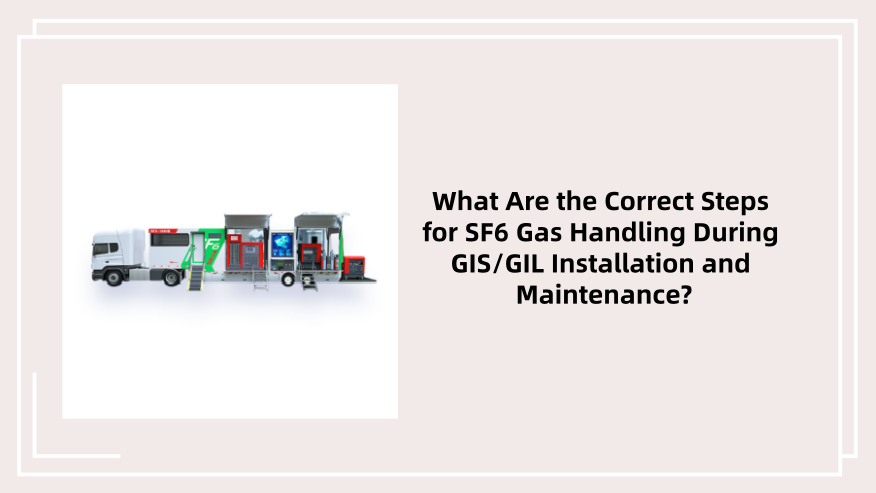
- SF6 Relations
- 2025-10-09
SF6 (sulfur hexafluoride) is a critical insulating and arc-quenching medium in Gas Insulated Switchgear (GIS) and Gas Insulated Transmission Lines (GIL), widely used in power grids for its excellent electrical insulation and thermal stability. However, improper SF6 gas handling during GIS/GIL installation and maintenance not only risks equipment failure but also violates environmental regulations—given SF6’s high global warming potential (GWP, 23,500 times that of CO₂ over 100 years). This article outlines key protocols for safe, compliant, and efficient SF6 gas handling throughout the GIS/GIL lifecycle.
1. Core Principles of SF6 Gas Handling for GIS/GIL
Before installation or maintenance, align with international standards (e.g., IEC 60480, IEEE C37.122) and manufacturer guidelines to prioritize three goals:
Purity Preservation: SF6 gas must meet industry purity standards (≥99.9% purity, moisture content ≤50 μL/L at 20℃, 101.3kPa) to avoid insulation breakdown. Contaminants like air, moisture, or oil can corrode GIS/GIL components or cause partial discharges.
Leak Prevention: GIS/GIL systems are designed for hermetic operation, but leaks during handling (e.g., loose fittings, damaged hoses) account for 80% of SF6 emissions. Leak rates must stay below 0.1% per year (as per EU F-Gas Regulation).
Worker Safety: SF6 is non-toxic but can displace oxygen in confined spaces, leading to asphyxiation. Additionally, arcing or high temperatures can decompose SF6 into toxic byproducts (e.g., SO₂, HF), requiring strict ventilation and PPE.
2. SF6 Gas Handling During GIS/GIL Installation
Installation is a high-risk phase for SF6 contamination and leaks. Follow these step-by-step protocols:
2.1 Pre-Installation Gas Preparation
Source Verification: Purchase SF6 gas from certified suppliers with test reports (purity, moisture, decomposition products). Re-test gas in on-site labs using a portable SF6 analyzer before use.
Equipment Inspection: Check SF6 handling tools (e.g., vacuum pumps, gas recovery units, hoses) for leaks. Hoses must be made of SF6-compatible materials (e.g., PTFE) and undergo pressure testing (≥1.5x the maximum operating pressure of GIS/GIL).
2.2 Gas Charging Process
Vacuuming the GIS/GIL Chamber: Before charging SF6, evacuate the chamber to a pressure ≤1 mbar (absolute) to remove air and moisture. Hold the vacuum for 24 hours to confirm no leaks—if pressure rises >0.5 mbar, identify and repair leaks (e.g., replace O-rings, tighten flanges).
Controlled Charging: Use a pressure-regulating valve to charge SF6 at a slow rate (<0.1 MPa/min) to avoid turbulence, which can trap moisture. Monitor gas temperature and pressure in real time; stop charging if the chamber temperature exceeds 40℃ (to prevent overpressure).
Post-Charging Verification: After charging, let the system stabilize for 24 hours, then test SF6 purity and moisture with a portable analyzer. If moisture exceeds 50 μL/L, use an SF6 drying unit to reduce humidity.
3. SF6 Gas Handling During GIS/GIL Maintenance
Routine maintenance (e.g., component replacement, leak detection) requires temporary SF6 recovery and recharging. Key steps include:
3.1 SF6 Recovery Before Maintenance
Recovery Equipment Setup: Connect a certified SF6 recovery unit to the GIS/GIL valve. Ensure the unit can achieve a final vacuum ≤5 mbar to recover ≥95% of SF6 gas (per IEC 60480).
Recovery Process: Recover SF6 in two stages: first, recover gas to medium pressure (≈0.5 MPa), then use a vacuum pump to extract residual gas. Store recovered SF6 in sealed, labeled cylinders (avoid mixing with new gas unless reprocessed).
3.2 Leak Detection During Maintenance
On-Site Leak Testing: Use a high-sensitivity SF6 leak detector (detection limit ≤1×10⁻⁶ mbar·L/s) to inspect flanges, valves, and cable entries. For large GIS/GIL systems, use the “enclosure method” (cover components with bags and measure SF6 concentration inside).
Repair and Re-Test: If leaks are found, depressurize the chamber, replace faulty parts (e.g., gaskets), and re-test until leak rates meet standards.
3.3 Recharging After Maintenance
Gas Reconditioning: If recovered SF6 has high moisture or impurities, pass it through a filtration-drying unit to restore purity. New SF6 can be added to top up pressure, but avoid mixing gases from different batches without testing.
Pressure Calibration: Recharge to the manufacturer’s specified pressure (e.g., 0.4–0.6 MPa for 110kV GIS) and confirm pressure stability over 12 hours.
4. Environmental and Regulatory Compliance
Given global efforts to reduce SF6 emissions (e.g., EU F-Gas Regulation, US EPA SNAP Program), proper handling must include:
- No Atmospheric Release: Never vent SF6 to the air—recover, reuse, or send to licensed recyclers.
- Emission Tracking: Maintain records of SF6 purchases, usage, recovery, and leaks for regulatory reporting.
- Training: Ensure all personnel handling SF6 are certified (e.g., IEC 60480 training) to follow best practices.
SF6 gas handling during GIS/GIL installation and maintenance is a critical link between power grid reliability, worker safety, and environmental protection. By adhering to strict purity controls, leak prevention, and recovery protocols, utilities can minimize equipment downtime, reduce emissions, and comply with global regulations. For long-term efficiency, invest in advanced SF6 handling tools (e.g., smart leak detectors, automated recovery units) and update procedures to align with evolving standards.
Leave a Reply